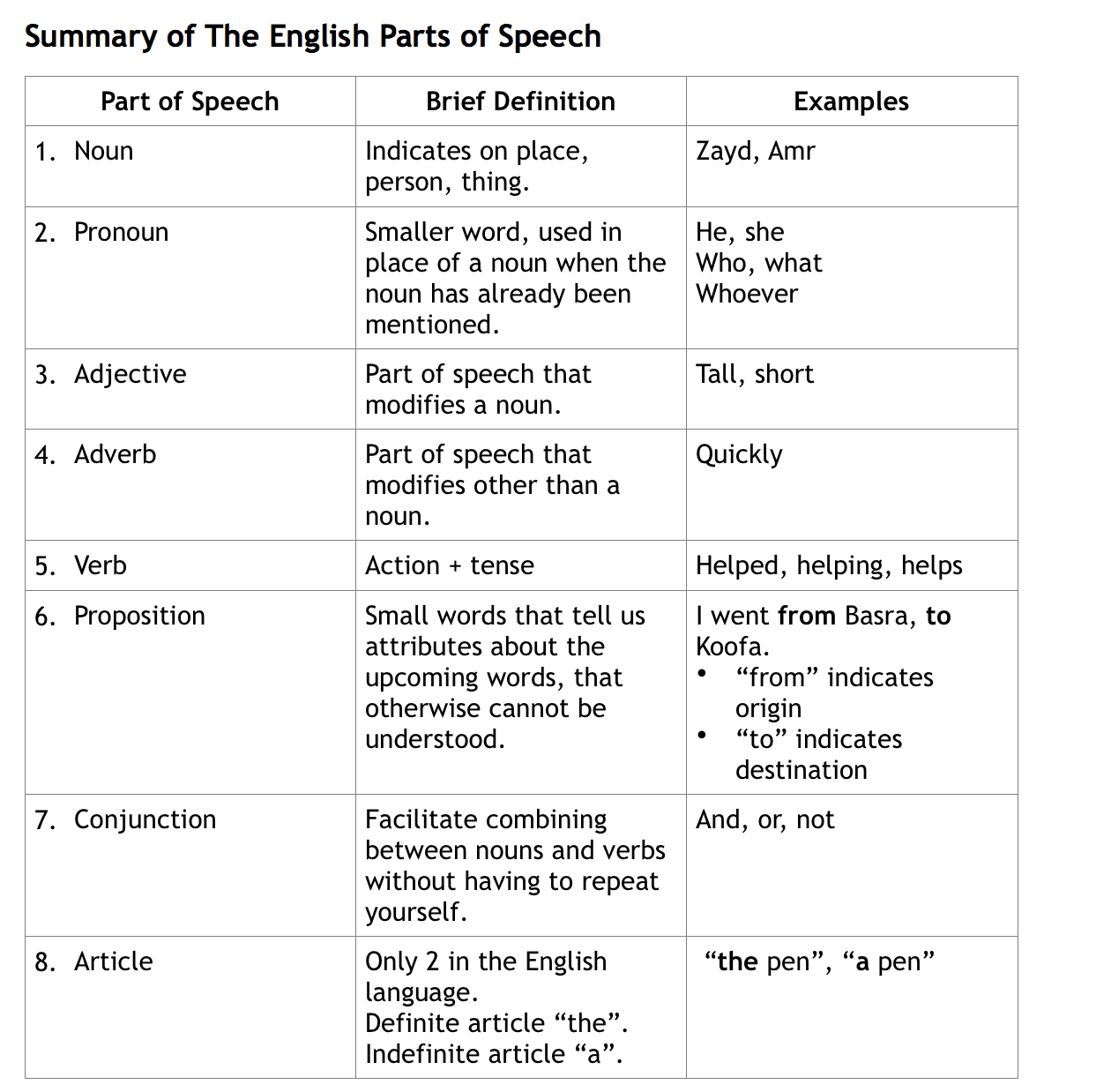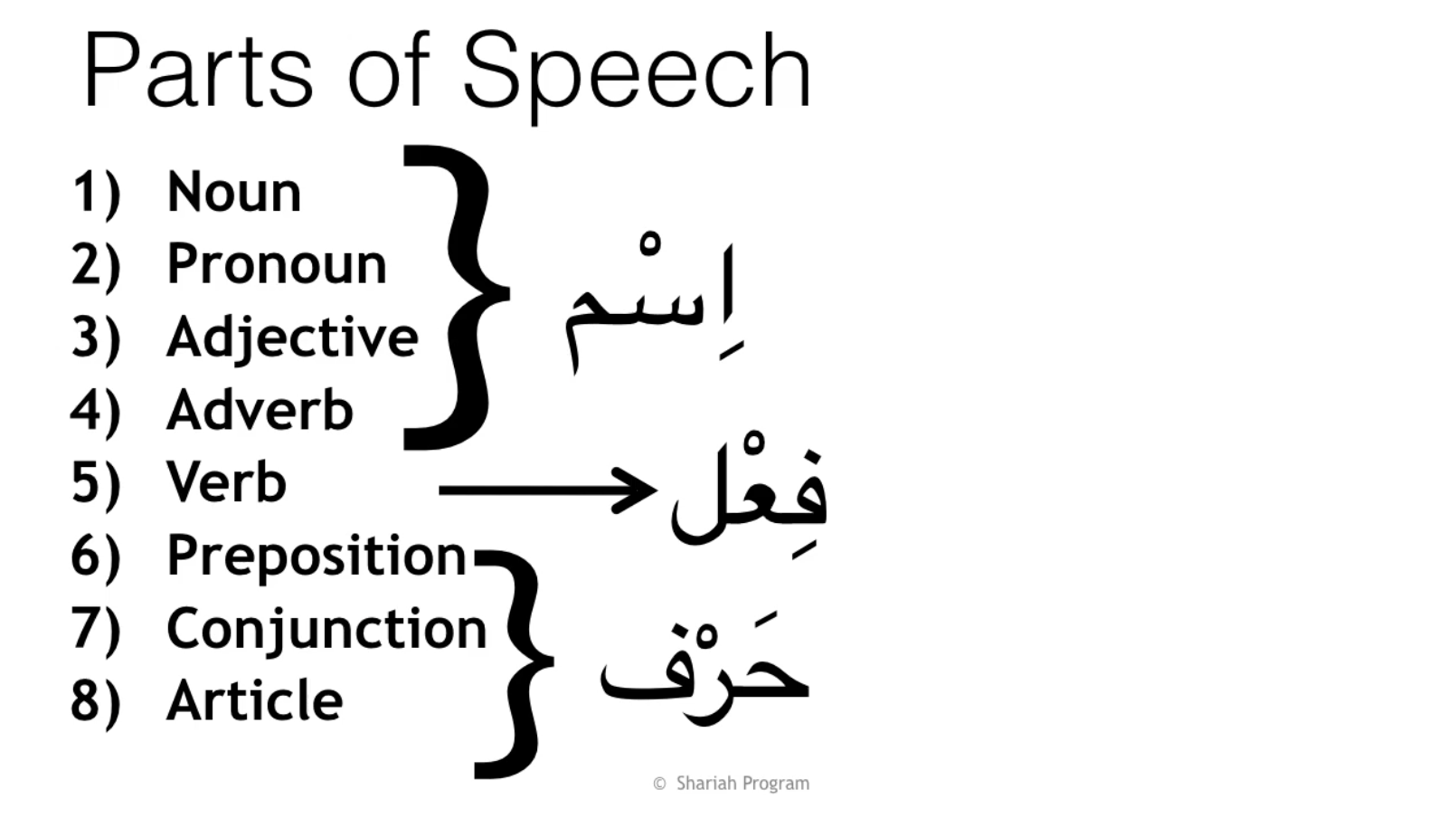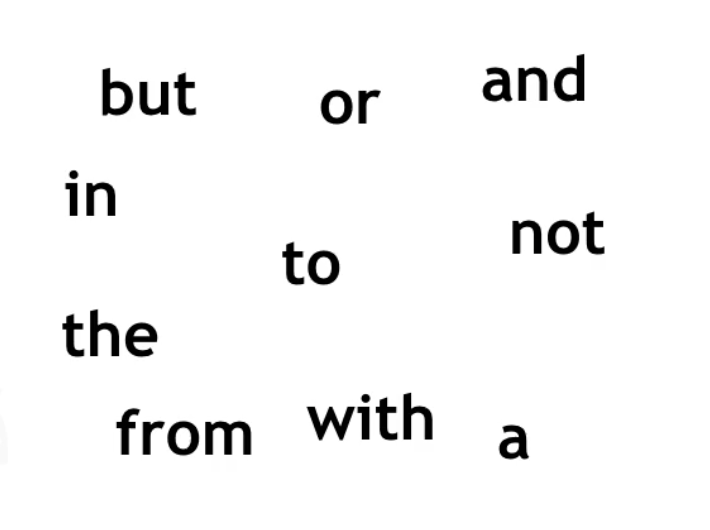“What Your Local Masjid’s Arabic Instructor Is Not Telling You About Why Most Students Struggle and Fail!”
I have GREAT news for you…
If you’ve ever asked yourself, In spite of dedicating so much time, effort and money, why am I not experiencing the results I was expecting?
And you’ve not received a satisfactory answer, then in this article I’d like to answer this question for you in a way that actually gives you hope and builds your confidence at the same time inshallah.
Laying the Groundwork
If you have studied Arabic for any length of time, undoubtedly you have come across these 3 terms: اِسْم [ism], فِعْل [fi’l] and حَرْف [harf].
اِسْم [ism] is generally translated as noun.
فِعْل [fi’l] is verb.
حَرْف [harf] is particle.
We want to develop them, and we want a crystal clear understanding of what these 3 are.
When people speak, they speak in sentences. Sentences are made up of phrases…
and phrases are made up of words.
So, you have to know the “word”. Luckily, in Arabic there are only 3 of them. In English there are more. There are 8+ parts of speech in English.
If we wanted to talk about the parts of speech in Arabic, and give definitions of them, we would revisit the ones we know in English.
If you are not familiar with the English parts of speech, that’s fine!
We will spend a few minutes talking about them. This is more productive than directly trying to define the اِسْم [ism], فِعْل [fi’l] and حَرْف [harf], as you will see.
English Parts of Speech
Very briefly, we have:
- 1. Nouns - entities, places, people, things, objects, concepts.
- 2. Pronouns - smaller words that are used in the place of a noun, when the noun has already been mentioned. There are various kind of pronouns. Examples:
- Personal Pronoun: he, she they, you, we.
- Interrogative Pronoun: words used to introduce questions. E.g. who, what.
- Conditional Pronoun: words used to create conditional statements . E.g. “whoever comes to you, honour him”.
3. Adjectives - modifies a noun. Examples: tall, small, ugly, beautiful.
4. Adverbs - modifies other than a noun. Examples: “came quickly”.
5. Verbs - action + tense. Examples: helped, helps, is helping, will help.
6. Prepositions - brings out an attribute of an upcoming word. Examples: from, to.
- “To” indicates destination. “From” indicates origin. When you line up the word “from” with an upcoming word and say: “I travelled from Basra to Koofa”. (Basra and Koofa are both names of cities). “From” told us that Basra is the origin of the travel. If you take away the “from” and say: “I travelled Basra”, then the meaning changes. Now it means I took a tour of Basra.
The word “from” is incredibly important. It told us something about Basra that otherwise we would not have been able to understand.
- “With” indicates that the upcoming noun is a tool. E.g. “I wrote with the pen”. It is telling us that the pen was a tool for the writing.
7. Conjunctions - these again are small words that are used to combine between nouns and verbs. They allow abbreviation, so you don’t have to repeat yourself. Examples:
- Zayd and Amr came. Instead of having to say “Zayd came. Amr came.” You can just use the word “and”. There is no need to say “came” twice, Now we have both Zayd and Amr gathered together in being the subject of the verb “came”.
- Zayd or Amr came. “Or” is telling us that one of the two came, without being specific which one.
- Zayd came, not Amr. “Not” is telling us that the earlier is established and the upcoming is being negated. “Coming” is established for Zayd, and simultaneously negated for Amr. I.e. affirmation of the first, and negation of the second.
What all conjunctions have in common is that they are used to combine between nouns and verbs, while allowing for abbreviation, so you don’t have to repeat yourself and say, for example the verb twice.
- 8. Article – there are only 2 in the entire language:
- The definite article “the”, which suggests something particular. E.g. the pen.
- The indefinite article “a”. E.g. a pen, which tells us any of many.

If there are any more parts of speech, then that doesn’t really matter. Our point right now is not to exhaust English grammar. We are using this as a bridge to facilitate our understanding of the Arabic Parts of Speech.
Parts of Speech in Arabic
Now, we take اِسْم [ism], فِعْل [fi’l] and حَرْف [harf] and line them up with these 8 Parts of Speech

1. اِسْم [ism] corresponds to nouns, pronouns, adjectives and adverbs.
2. فِعْل [fi’l] corresponds exactly to verb.
3. حَرْف [harf] corresponds to prepositions, conjunctions and articles. (If there are any more, they would come under حَرْف)
Now that we have a good understanding of what اِسْم [ism], فِعْل [fi’l] and حَرْف [harf] correspond to, it is time to give precise definitions for each of them.
Commonalities and Differences
In order to define, we spend a few minutes pondering on the commonalities and the differences.
حَرْف [harf] doesn’t just include one thing, it includes three things. It includes prepositions, conjunctions and articles.
Without any particular order, we will throw up some prepositions, conjunctions and articles. Then we will look at what is common between all of them. We will try to figure what the element is that is the same in all of them. That would be the حَرْف [harf]. If it doesn’t have that, then it would be one of the other two (اِسْم [ism] or فِعْل [fi’l]).
We would do the same thing with the other two and try to look for a difference there. What is it that distinguishes the verb from nouns, pronouns, adjectives and adverbs.
We can start by throwing up some prepositions, conjunctions and articles on the screen:

These are all examples of حَرْف [harf]. What do they have in common? Let’s look at their meanings.
*“And” indicates gathering. E.g. Zayd and Amr came. “And” gathered Zayd and Amr together.
*“Or” indicates disjunction, that it is one of the two the ruling is applying to, not both (without being specific which one).
*“Not” indicates affirmation of the first and negation of the second. E.g. Zayd came, not Amr. The “coming” is affirmed for Zayd and simultaneously negated for Amr.
*“In” indicates containment. E.g. “The water is in the bottle”.
*“From” indicates origin.
*“With” indicates utility.
If you look at all of them, you have to agree that the commonality is that they all indicate meanings in something else. Because origin is not the attribute of the “from”, it is an attribute of the upcoming word.
Like in the example “I went from Basra to Koofa”. “From” is an attribute of “Basra”. If you remove it (and say, I traveled Basra), the meaning changes, and the origin meaning is the element that disappears. The meaning would be “I took a tour”.
All حَرْف [harf] are all like that.
Contrast that to the word “tree” which would not be a حَرْف [harf]. “Tree” is an example of a noun. It indicates trunk, roots, branches, leaves, maybe fruit. All of those things, are they contained within the tree or are they contained outside the tree? Clearly, the tree. It is the tree that has the trunk, roots, branches, leaves and fruits.
We have 2 elements here: indicating a meaning in something else vs. indicating a meaning in itself.
If it indicates a meaning in something else, then that is the primary ingredient that makes a حَرْف [harf] a حَرْف [harf].
If it indicates a meaning in itself, then that is the primary ingredient that makes it اِسْم [ism] or فِعْل [fi’l].
Since there is more of them, there is something distinguishing the top 4 (nouns, pronouns, adjectives and adverbs) from the verb. And that is tense.
The noun, pronoun, adjective and adverb indicate meanings in themselves and are empty of tense.
Whereas the فِعْل [fi’l]has tense.
Precise Definitions
اِسْم [ism] is the Part of Speech in Arabic that indicates a meaning in itself and is not linked to time. Examples:
زَيْد (Zayd)
شَجَرَة (tree)
قَلَمٌ (pen)
الشَّمْسُ (the sun)
الْقَمَرُ (the moon)
فِعْل[fi’l] is the part of speech in Arabic that indicates a meaning in itself and is also linked to time. Examples:
ضَرَبَ (hit)
سَمِعَ (heard)
نَصَرَ (helped)
أَكْرَمَ (honoured)
اِسْتَنْصَرَ (sought help)
حَرْف [harf] is the part of speech in Arabic that does not indicate upon a meaning in itself, but rather in something else. Examples:
مِنْ (from)
فِي (in)
وَ (and)
أَوْ (or)
So that is it. That is the development of the Parts of Speech.
We did it by surfacing the English Parts of Speech, spending a few minutes on them, and then immediately lining up the Arabic Parts of Speech with the English ones, to try to get a feeling and understanding of what they correspond to. Then we looked for the commonalities and differences which then led us to the definitions.
This topic is now totally done. It is done in a way that I don’t think you will forget insha’Allah. If you were made to present it I think you would also do it with confidence.
To answer the original question:
In spite of dedicating so much time, effort and money, why am I not experiencing the results I was expecting?
The answer is simple.
It has everything to do with not being aware of the fundamental nature of how the language works. I.e. the approach and method means everything. When you are studying Arabic, as a series of disconnected rules, and long list of words. And you feel that the only way to master the language is to memorize vocabulary and rules, without understanding how the language works, and without appreciating how the Arabic language is different, unique and special, then of course this will overwhelm and disappoint you and not give you the results you are looking for.
It doesn’t matter if you are studying online, or studying in a physical classroom, or if you are studying through a live presentation or whether it is pre-recorded. None of that matters! The preferred learning style comes later. The approach is the sole factor that determines whether the person gets results or not.
Join Me for a Free 3-Part Mini-Class That Will Cover More Than a Years Worth of University Arabic
If you feel like this article was helpful, you are a great fit for the free How To Start Understanding Quranic Arabic In 21 Days mini-class I put together for those that are looking to gain traction in their Arabic studies without the stress of having to memorize long lists of vocabulary or disconnected rules.
This training is packed with information and 100% Free.
Perhaps the most important lesson in this new mini-class is the emphasis on the way Arabic is structured, its comprehensiveness and the true reason why Allah azza wa jall chose it as the medium for his final message.
Sign up now by clicking the banner below and filling the short form. I’ll also send you a 3 page “English Grammar Terminology” worksheet.
After over 16 years of teaching, I’ve noticed that it’s not the Arabic that my students have trouble with, but actually, it’s their understanding of English grammar.
So, inshaAllah, just getting this part down will help ensure that you have a solid foundation for learning Arabic.
May Allah reward you for the best of your intentions and grant you barakah in your time and effort.